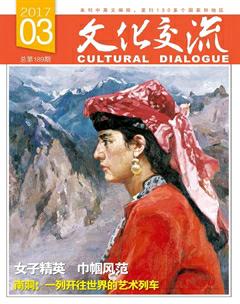最是桃歌解乡愁
陈伟权
三月桃花映面红,桃林如锦笑春风。
在奉化的车站、码头等交通要道,可见醒目标志:“奉化——桃花盛开的地方”。溪口镇新建村有世界桃街,还有筹建中的中国桃花博物馆,并将举行奠基仪式。那里桃花灼灼,一派乡村野趣,也是有名的宜游宜居之地。
崛起世界桃街
奉化萧王庙街道以产水蜜桃著称,是宁波市首批三个浙江省特色农业强镇之一。从萧王庙“天下第一桃园”出发,不上10分钟,世界桃街就呈现在面前。
世界桃街凝结的桃文化绚丽厚重。2000年奉化第一届桃花节在新建村举办。著名歌唱家蒋大为在世界桃街唱响《在那桃花盛开的地方》,游人云集,声闻于天,情动于地,歌声引出连串故事。
人们由此得知,激发歌词的作者邬大为创作灵感的竟是他的奉化同乡、溪口镇19岁的小战士王武位。那年邬大为作为沈阳军区歌舞团创作员,到零下40摄氏度的珍宝岛体验生活,恰遇王武位。王武位说到当时家乡正桃花盛开,心里也变得温暖。邬大为说奉化带给小战士的精神力量,有天下最美的桃花。事隔16年,歌词作者邬大为、作曲者铁源和蒋大为都莅临奉化歌唱桃花,蒋大为风趣地说:“奉化溪口是蒋氏故里,我也姓蒋,觉得自己和奉化很有缘分。”
“世界桃街”的行楷大字,自然洒脱,镌刻在巨大岩壁上。桃街两边栽有来自国内外的100多个桃树品种,包括北京的京华红珠、大连的连黄、山东的雪桃、南京的菊花露、郑州的曙光、徐州的徐蜜、无锡的湖景蜜桃等,更有浙江各地的多个桃树品种,桃街还栽有美国的白桃、农神蟠桃,而来自日本的桃树品种多达10多个。在当地水蜜桃研究所技术人员指导下,桃农探索不同品种的生长特性,精心培育,致使桃街赏花期长、花色深浅斑斓,而且桃子果实风味各异。桃街上立有“全国水蜜桃优质高产示范基地”的指示牌。
观赏桃花,景致不同,感受也不一样。萧王庙的桃花连片火红。置身世界桃街,见淡淡远山、萋萋芳草、浓浓花丛,幽境中花朵有的含苞欲放,更多的迎风绽开,在三月春风中姹紫嫣红,桃街竞显风流。
谱写新桃花源
桃源仙境,那是古代不食人间烟火的仙人住地,而常人居住的桃境则多留有乡愁。5A级风景名胜区溪口雪窦山美景诱人,也积淀乡愁。新建村有个法华寺,从前寺边有蒋氏家产竹山。少年蒋介石常随母亲王采玉到法华寺礼佛,常听母亲诉说娘家在溪口葛竹。1947年4月,蒋介石夫妇携后代上法华寺品味野菜,乡愁依稀。
新建村村民委员会主任唐方良说,新建村隶属于溪口镇,但村里没有名人,没有名宅,却可建设古人梦想中的桃源美景。在村党支部的领导下,组织村民拓宽农业观光大道,仅用一星期时间完成20户人家的房屋拆建,又组织整修流经村中大溪,实施天蓝水清村干净工程。早年建成一排排村民新居,错落有致,门前小溪清流涓涓;村中公园古树伟岸挺拔,卵石巨岩点缀着小桥、流水,印证着村口牌楼所示桃源仙境。
他们还施展大手笔,与建设和延伸世界桃街项目同步,营造四季花海,建设数百亩的梅花基地,梅花先报春消息,人间春风桃花红。大面积油菜花盛开,连片成黄金海洋,吸引大批游客、市民前来观赏。那里还有一排排小木屋,不仅可提供当地有名的土特产,供人休闲、饮食,而且能让人在田野观花踏青,放飞心情,享受桃花节一样的浪漫风情。
村党支部书记唐敦大与唐方良紧密配合,带动村民把闲置的房舍改建成民宿,游客可以像在家中一样住宿,流连忘返。他们又把宗祠修葺成文化礼堂,墙上表彰村中杰出的人事和大学生姓名、事迹,以弘扬全村正能量。
春风桃花育新风。奉化历年的水蜜桃文化节期间游人如云,2016年到新建村游览的每天有3万人,最多一天达3.6万人,这对仅有500多户人家的农村是一场挑战与机遇并存的考验。村里组织200多名志愿者服务游客。志愿者事先经过培训,把文明待客的种种举措一一落实,并率先垂范。桃花节活动场面热烈、人山人海,但新建村里村巷清洁,秩序井然。
村干部带领村民谱写桃花源。唐方良从早到夜是个大忙人,村里来了客人要迎接,村民有事要协调,奔上奔下忙村务。为了“大我”舍“小我”,唐方良原本外出办企业长达20年,事业有成。如今大家信任,他回村当干部,个人收入减少不说,以儿子求学来说,原在宁波有名的学校念书,现在也得跟他回奉化读书。
尽显桃文化魅力
新建桃源风景美、人气旺,也带来人脉。唐方良等一批村干部寻觅商机,组建全通发展有限公司,招聘电商达人,以诚信、守信、服务为上,发挥他们的才智开拓电子商务,赢来众多顾客网购。从村里走出去的大学毕业生郑瑜昕在上海已有工作岗位,也被招回村创业,从事公司电商业务。2016年吉林省有22个县的相关人员来到奉化溪口新建村取经;同年10月,新建村被评上浙江省首批农村电子商务示范村,预计今年水蜜桃上市后,新建村网购会更加热火。
世界桃街衍生桩桩美事,但称得上大手笔的要数中国桃花博物馆奠基仪式。它被人们通称为桃花馆,已筹建多时,一年前通过媒体发布信息,向全球招聘馆长。1600多年前陶渊明写的《桃花源记》美梦在这里即将成真,设计方案中有桃花历史、桃花故事、桃花诗词以及桃对身体的保健作用等。就以桃的历史来说,新石器时代河姆渡遗址有野生桃树遗存,两千多年前的《诗经》已有桃的诗歌,一千多年前文字记载的四明山洞天中仙女桃事,就在古代的溪口地域,直到150多年前溪口桃农依托当地水土优势,嫁接从外地引入的优良桃种,培育琼浆玉露水蜜桃,名扬万里。1996年,国务院发展研究中心等部门联合命名奉化为“中國水蜜桃之乡”。近20年来,有60多批境外果树专家到奉化溪口考察。
桃花博物馆将计划举行奠基仪式时,在现场安排多个图文并茂的展板,在展示桃对人体的保健作用时,必然会介绍奉化水蜜桃的诱人美味。毛泽东主席曾对来自浙江的身边工作人员赞许:“浙江的水蜜桃又甜又香。”奉化水蜜桃无疑是最佳的。用手触摸软绵绵的成熟桃子,你可看到半透明的果肉,它会化成可口蜜汁,用一根吸管戳破表皮,伸入到果肉中,即可吸吮到甜爽鲜美的桃汁。难怪三四月山桃花时节,客户、游人都向电商预订七八月份的奉化水蜜桃呢!
奉化是寧波市的一个美丽城区,每年3月至10月奉化水蜜桃文化节就像展示生态文明的皇冠,而溪口新建村的民办桃街则是皇冠上一颗熠熠闪光的明珠,尽显桃文化的无穷魅力,也为建设宁波现代化国家港口名城增添光彩。
Village in Fenghua Presents World Peach Street
By Chen Weiquan
Wherever you go in Fenghua, you see the slogan “Fenghua, where the peach blossoms in full bloom”. As Chinas ‘peach capital, Fenghua is the right place to be for a spring outing soaked in the perfume of peach petals. The citys Xikou Town is home to the Chinas only ‘Peach Street and Peach Museum, drawing tourists from all over the country for its pastoral charm.
Famed for its significant production of juicy peach, Xiaowangmiao ranks as one of the top three provincial-level agricultural towns in Ningbo. The World Peach Street is only about 10 minutes drive from the Worlds Number One Peach Orchard in the towns Xinjian Village, where the first Fenghua Peach Blossoms Festival was held in 2000. The festivity opened in the beautiful melody of Where the Peach Blossoms in Full Bloom, the most famous song by singer Jiang Dawei.
According to the songs lyricist Wu Dawei, the inspiration came from Wang Wuwei, a Fenghua native from Xikou Town. When the 19-year-old Wang Wuwei told him that it was his memories about the peach blossoms of his hometown that brought the spiritual power for him to survive the killing cold in the isolated island, Wu Dawei was so moved that he wrote a song.
The ‘Peach Street is flanked with more than a hundred peach species and nectarine cultivars known to the world, including a dozen varieties from Japan, white peach and flat peach (or pan-tao which has a flattened shape in contrast to ordinary rounded peaches) from America, and such famous domestically cultivated varieties as the Jinghua Hongzhu, Lianhuang, the Snow White, Chrysanthemum Dew, Shuguang, Xumi and Hujing.
Genetic studies suggest peaches originated in China, where they have been cultivated since the early days of Chinese culture. Until recently, it was believed that the cultivation started circa 2000 BC. Nevertheless, the recent evidence indicates that domestication occurred as early as 6000 BC in Zhejiang Province. The oldest archaeological peach stones have been excavated from the Hemudu site in todays Yuyao, Ningbo. Archaeologists point at the Yangzi River valley as the place where the early selection for favorable peach varieties likely took place.
Peaches were mentioned in Chinese writings as far back as the 10th century BC and were a favored fruit of kings and emperors, and obviously inspired the authors of , the oldest collection of poems compiled and edited by Confucius more than 2,500 years ago. The history of cultivation of peaches in China has been extensively reviewed citing numerous original manuscripts dating back to 1100 BC.
In 1996, Fenghua became Chinas ‘juicy peach capital, a title officially granted by the Development Research Center of the State Council. The city has since been drawing fruiter experts from all over the world.
At the peach museum, visitors are able to learn about the cultivation history, planting and nutritional facts of the Fenghua peach. During one of his visits to Zhejiang, Chairman Mao mentioned how he was impressed by the uniquely fine quality of peach produced in the province. The citys juicy peaches are of such a peerless quality that the peach dealers in Fenghua have to handle orders from tourists and company buyers months earlier than the ripening season.
For a first-hand experience of the peach culture of Fenghua, the citys annual peach revelry that lasts more than six months from March to October is also open to all. In 2016, Xinjian Village received an average of about 30,000 peach lovers daily during the Fenghua Peach Festival.
The engaging scenery of Xuedou Mountain area must not be missed for any sane traveler. For cultural buffs, Fenghua has a lot of cultural spots to offer. In April of 1947, Chiang Kai-shek and his wife Song Meiling paid a visit to the Fahua Temple in Xinjian Village. A firm believer in Buddhism, his mother Wang Caiyu spent a lot of time here when Chiang Kai-shek was a teenager.

